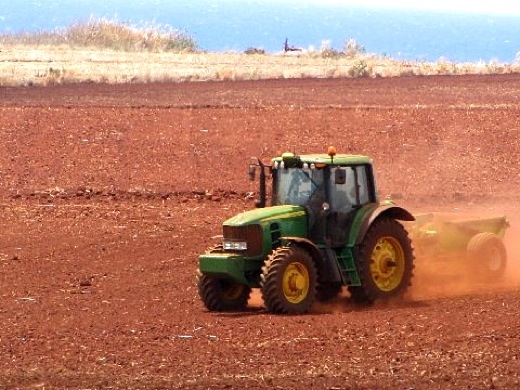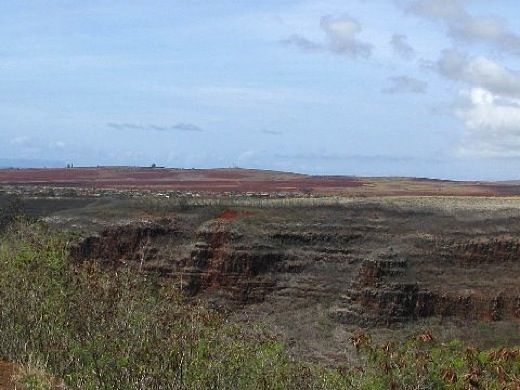SUBHEAD: Dow AgroScience is speedily turning thousands of acres of what used to be sugarcane into a GMO laboratory next to residences in Hanapepe Heights.
By Diana Labedz on 4 November 2010 for Island Breath -
(http://islandbreath.blogspot.com/2010/11/gmo-fields-forever.html)

Image above: Dow tractor preparing G&R cane field for GMO experiments. All photos by Diana Labedz.
These photo's are of the growing number of GMO fields on the Westside, near the community Hanapepe Heights. I could not capture with a camera the extent of how many or how far the fields have grown. It hurts my heart to see it. How many acres? How long will they be here? Is anyone monitoring the dust, land, air and water for chemical pollution?

Image above: Field between Kaumakani and Hanapepe Heights to be spayed with glyphosate and other chemicals.
What are the consequences of the ongoing assaults to the people that live and work on the Westside? Is there a way that could transform these fields into healthy crops that would feed, clothe and provide medicine to the island people?

Image above: Dust is kicked up in fields behind cliff side residences of Hanapepe Heights.
Is there a way to channel this negative energy in a manner that will enable the island to overcome the temporary obstacles and provide lush green organic food, prosperity, fertility and rejuvenation? Can we purge and start fresh after encountering these difficult situations? Or will there be GMO fields forever?
See also:
Ea O Ka Aina: Message from Dow GMO 6/29/10
Ea O Ka Aina: Kaumakani - Toxic Village 8/15/10
Ea O Ka Aina: End of Kauai's Economy 7/7/10
Ea O Ka Aina: KIUC - PacWest - G&R Deal 10/16/09
Ea O Ka Aina: Kauai's last sugar harvest 9/28/09
Ea O Ka Aina: Gay & Robinson Future 9/27/09
.
By Diana Labedz on 4 November 2010 for Island Breath -
(http://islandbreath.blogspot.com/2010/11/gmo-fields-forever.html)

Image above: Dow tractor preparing G&R cane field for GMO experiments. All photos by Diana Labedz.
These photo's are of the growing number of GMO fields on the Westside, near the community Hanapepe Heights. I could not capture with a camera the extent of how many or how far the fields have grown. It hurts my heart to see it. How many acres? How long will they be here? Is anyone monitoring the dust, land, air and water for chemical pollution?

Image above: Field between Kaumakani and Hanapepe Heights to be spayed with glyphosate and other chemicals.
What are the consequences of the ongoing assaults to the people that live and work on the Westside? Is there a way that could transform these fields into healthy crops that would feed, clothe and provide medicine to the island people?

Image above: Dust is kicked up in fields behind cliff side residences of Hanapepe Heights.
Is there a way to channel this negative energy in a manner that will enable the island to overcome the temporary obstacles and provide lush green organic food, prosperity, fertility and rejuvenation? Can we purge and start fresh after encountering these difficult situations? Or will there be GMO fields forever?
See also:
Ea O Ka Aina: Message from Dow GMO 6/29/10
Ea O Ka Aina: Kaumakani - Toxic Village 8/15/10
Ea O Ka Aina: End of Kauai's Economy 7/7/10
Ea O Ka Aina: KIUC - PacWest - G&R Deal 10/16/09
Ea O Ka Aina: Kauai's last sugar harvest 9/28/09
Ea O Ka Aina: Gay & Robinson Future 9/27/09
.
2 comments :
Auwe! This makes me angry. What can be done? Why experiment with a fragile environment like Hawaii?
So Sad...also heard Monsanto just bought a large tract on Molokai to test more GMO. YUCK. We need more sustainable ag especially on the sacred lands of Hawai'i
Post a Comment